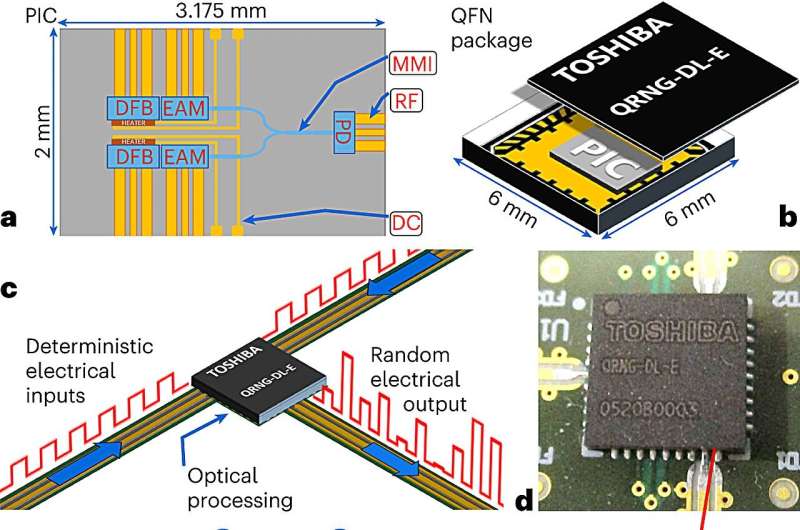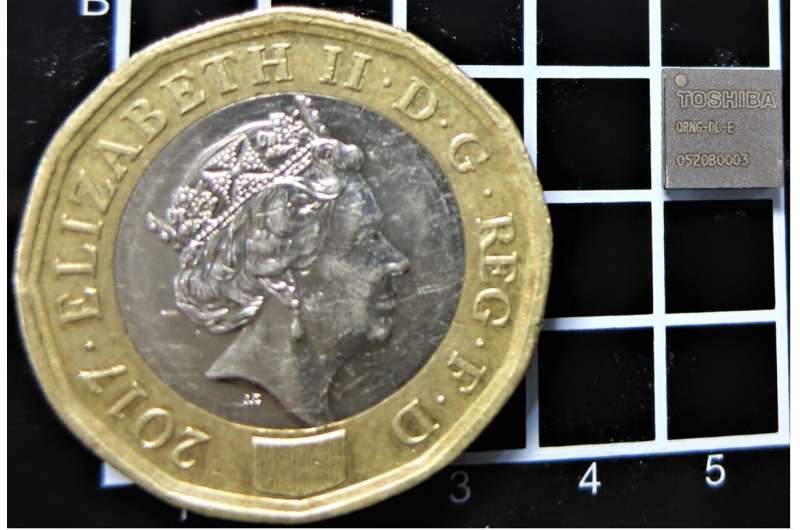
JUNE 11, 2024 by Ingrid Fadelli , Tech Xplore
Collected at : https://techxplore.com/news/2024-06-quantum-random-generator-gbits.html
The reliable generation of random numbers has become a central component of information and communications technology. In fact, random number generators, algorithms or devices that can produce random sequences of numbers, are now helping to secure communications between different devices, produce statistical samples, and for various other applications.
Researchers at Toshiba Europe Ltd. recently developed a new quantum random number generator (QRNG) based on a photonic integrated circuit that can be directly integrated in electronic devices. This QRNG, introduced in a paper published in Nature Electronics, can securely and robustly generate random numbers at a remarkable speed of 2 Gbit s-1.
“Randomness is now a valuable commodity, as it drives nearly all digital protocols that enable private communication,” Raymond Smith, Senior Research Scientist and co-author of the paper, told Tech Xplore.
“The common use of pseudo-random number generators (PRNGs) poses a potential security threat because PRNGs are merely deterministic algorithms and do not provide true randomness. This is particularly critical for secure communication systems.”
Recent studies have highlighted the potential of generating truly unpredictable numbers using QRNGs, random number generators that leverage natural processes of a quantum origin. Smith and his colleagues at Toshiba have been experimenting with these techniques.
“Previous research efforts and ideas that inspired this work include the quest to simplify the hardware of QRNGs,” Smith said.
“Typically, QRNGs employ photonic components such as lasers and detectors, which are bulky and require special handling when assembled with electronics. This complexity makes QRNGs more challenging to deploy on a large scale and more expensive. However, a technology called ‘integrated photonics’ is helping to overcome these challenges.”
Integrated photonics circuits allow researchers to condense all central optical components into a single chip that is only a few millimeters in size. Smith and his colleagues tried to use integrated photonics technologies to create a photonic integrated circuit (PIC) that could simplify the complexity of their QRNG method, facilitating its future large-scale deployment.
“Over recent years, Toshiba has made a number of advances in PIC technology, including the development the world’s first chip-based quantum key distribution (QKD) system,” Smith said.
“This QKD system incorporated a QRNG PIC in a 14-pin butterfly package whose optical output needed to be fiber-coupled to a high-speed photodiode on the QRNG electronic board.”

The primary objective of the recent study by the team at Toshiba was to develop a fully-fledged QRNG based on a PIC with only electronic inputs and outputs. In addition, the researchers planned to deploy the QRNG on real devices to validate its effectiveness.
“Typically, PICs are tested under controlled conditions using specialized laboratory equipment,” Smith explained. “This approach makes it difficult to assess the performance of this technology once deployed in real systems, under real operating conditions.”
More information: Davide G. Marangon et al, A fast and robust quantum random number generator with a self-contained integrated photonic randomness core, Nature Electronics (2024). DOI: 10.1038/s41928-024-01140-0.
Journal information: Nature Electronics

Leave a Reply